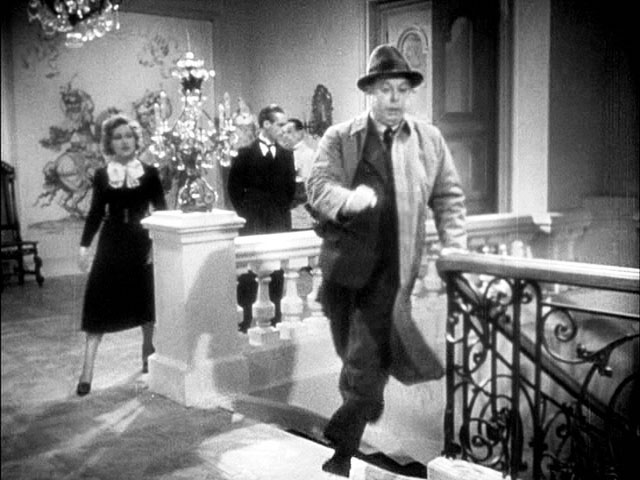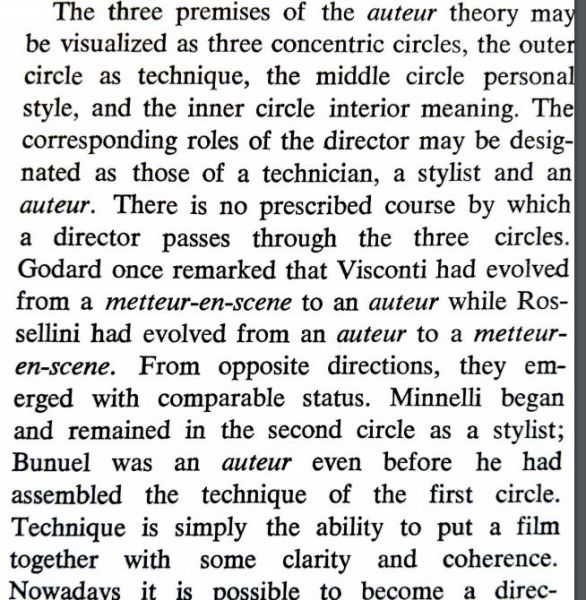Difference between pages "JCM412512/Analytical Exercise (Discussion)" and "Concept of Authorship (Discussion)"
From Screenpedia
(Difference between pages)
Jump to navigationJump to search (rm questions about productive discussion) |
|||
| Line 1: | Line 1: | ||
| − | + | ==Readings== | |
| − | + | ===Introduction, by John Caughie=== | |
| − | + | '''Group 1''' | |
| − | #What | + | #What are the basic assumptions of auteurist critics? |
| − | #How | + | #How did auteurism differ from previous film criticism? |
| − | |||
| − | |||
| − | |||
| − | |||
| − | |||
| − | |||
| − | |||
| − | |||
| − | |||
| − | == | + | === Edward Buscombe === |
| + | '''Groups 2 and 3''' | ||
| + | #What elements of romanticism underpin auteurism? | ||
| + | #What is the difference between Hawks and "Hawks"? | ||
| − | <gallery mode="packed" heights= | + | === Andrew Sarris === |
| − | File: | + | '''Group 4 and 5''' |
| − | + | #What, according to Sarris, are the three premises of the auteur theory? | |
| − | + | #From "Notes on the Auteur Theory," but not in the excerpt: "The three premises of the auteur theory may be visualized as three concentric circles, the outer circle as technique, the middle circle personal style, and the inner circle interior meaning." | |
| − | + | #*Explain, if you can, what Sarris means by "élan of the soul". (See Pauline Kael's criticism of this phrase below.) | |
| − | File: | + | #What does Sarris mean when he uses the term "mise-en-scene"? ('''Hint''': it's ''not'' how it's used in ''Television''.) |
| + | #*And how does this image (below) illustrate it? | ||
| + | <gallery mode="packed" heights=400px> | ||
| + | File:Rules Moment07.jpg|alt=Jean Renoir in ''Rules of the Game'' (French title: ''La Règle du jeu'').|Jean Renoir in ''Rules of the Game'' (French title: ''La Règle du jeu''). | ||
| + | File:Sarris - Notes - Circles.jpg|alt=Andrew Sarris, "Notes on the Auteur Theory," Film Culture, No. 27 (Winter 1962/3), 7.|Andrew Sarris, "Notes on the Auteur Theory," ''Film Culture'', No. 27 (Winter 1962/3), 7. | ||
</gallery> | </gallery> | ||
| − | + | Pauline Kael, "Circles and Squares," ''Film Quarterly'' (reprinted in ''I Lost It at the Movies''), response to Sarris: | |
| − | + | :Sarris believes that what makes an auteur is "an élan of the soul." (This critical language is barbarous. Where else should élan come from? It's like saying "a digestion of the stomach." A film critic need not be a theoretician, but it is necessary that he know how to use words. This might, indeed, be a first premise for a theory.) Those who have this élan presumably have it forever and their films reveal the "organic unity" of the directors' careers; and those who don't have it - well, they can only make "actors' classics." It's ironic that a critic trying to establish simple "objective" rules as a guide for critics who he thinks aren't gifted enough to use taste and intelligence, ends up - where, actually, he began - with a theory based on mystical insight. | |
| − | + | ||
| − | + | === ''Movie'' === | |
| − | + | '''All groups (after you've answered the questions above):''' | |
| + | #What was ''Movie''? | ||
| + | #How did ''Movie'''s approach to auteurism differ from that of ''Cahiers du Cinéma''? | ||
== Bibliography == | == Bibliography == | ||
| − | + | All from ''Theories of Authorship'', John Caughie, ed. (Boston: Routledge & Kegan Paul, 1981): | |
| + | |||
| + | #Introduction, John Caughie, 9-16. | ||
| + | #Edward Buscombe, "Ideas of Authorship," 22-34. | ||
| + | #''Cahiers du Cinéma'', 35-47. | ||
| + | #''Movie'', 48-60. | ||
| + | #Andrew Sarris, 61-67. | ||
==External links== | ==External links== | ||
| − | #[ | + | #[https://tvcrit.org/Classes/Jbutler/T440/AuteurTheory.php Auteur Theory Illustrations] |
| − | # | + | #[https://tvcrit.org/Classes/Jbutler/T340/Bazin03.php Auteurism's defining moment], according to Sarris. |
[[Category:JCM412/512 Discussion]] | [[Category:JCM412/512 Discussion]] | ||
| + | [[Category:TCF440/540 Discussion]] | ||
Revision as of 21:00, 14 February 2020
Readings
Introduction, by John Caughie
Group 1
- What are the basic assumptions of auteurist critics?
- How did auteurism differ from previous film criticism?
Edward Buscombe
Groups 2 and 3
- What elements of romanticism underpin auteurism?
- What is the difference between Hawks and "Hawks"?
Andrew Sarris
Group 4 and 5
- What, according to Sarris, are the three premises of the auteur theory?
- From "Notes on the Auteur Theory," but not in the excerpt: "The three premises of the auteur theory may be visualized as three concentric circles, the outer circle as technique, the middle circle personal style, and the inner circle interior meaning."
- Explain, if you can, what Sarris means by "élan of the soul". (See Pauline Kael's criticism of this phrase below.)
- What does Sarris mean when he uses the term "mise-en-scene"? (Hint: it's not how it's used in Television.)
- And how does this image (below) illustrate it?
Pauline Kael, "Circles and Squares," Film Quarterly (reprinted in I Lost It at the Movies), response to Sarris:
- Sarris believes that what makes an auteur is "an élan of the soul." (This critical language is barbarous. Where else should élan come from? It's like saying "a digestion of the stomach." A film critic need not be a theoretician, but it is necessary that he know how to use words. This might, indeed, be a first premise for a theory.) Those who have this élan presumably have it forever and their films reveal the "organic unity" of the directors' careers; and those who don't have it - well, they can only make "actors' classics." It's ironic that a critic trying to establish simple "objective" rules as a guide for critics who he thinks aren't gifted enough to use taste and intelligence, ends up - where, actually, he began - with a theory based on mystical insight.
Movie
All groups (after you've answered the questions above):
- What was Movie?
- How did Movie's approach to auteurism differ from that of Cahiers du Cinéma?
Bibliography
All from Theories of Authorship, John Caughie, ed. (Boston: Routledge & Kegan Paul, 1981):
- Introduction, John Caughie, 9-16.
- Edward Buscombe, "Ideas of Authorship," 22-34.
- Cahiers du Cinéma, 35-47.
- Movie, 48-60.
- Andrew Sarris, 61-67.
External links
- Auteur Theory Illustrations
- Auteurism's defining moment, according to Sarris.

